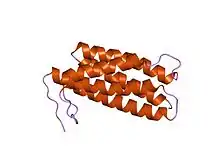| ATP:corrinoid adenosyltransferase | |||||||||
|---|---|---|---|---|---|---|---|---|---|
 | |||||||||
| Identifiers | |||||||||
| EC no. | 2.5.1.17 | ||||||||
| CAS no. | 37277-84-2 | ||||||||
| Databases | |||||||||
| IntEnz | IntEnz view | ||||||||
| BRENDA | BRENDA entry | ||||||||
| ExPASy | NiceZyme view | ||||||||
| KEGG | KEGG entry | ||||||||
| MetaCyc | metabolic pathway | ||||||||
| PRIAM | profile | ||||||||
| PDB structures | RCSB PDB PDBe PDBsum | ||||||||
| Gene Ontology | AmiGO / QuickGO | ||||||||
| |||||||||
| ATP:corrinoid adenosyltransferase | |||||||||
|---|---|---|---|---|---|---|---|---|---|
 the three-dimensional structure of atp:corrinoid adenosyltransferase from salmonella typhimurium. apo-atp form | |||||||||
| Identifiers | |||||||||
| Symbol | CobA_CobO_BtuR | ||||||||
| Pfam | PF02572 | ||||||||
| Pfam clan | CL0023 | ||||||||
| InterPro | IPR003724 | ||||||||
| SCOP2 | 1g64 / SCOPe / SUPFAM | ||||||||
| |||||||||
| Cobalamin adenosyltransferase (PduO/EutT) | |||||||||
|---|---|---|---|---|---|---|---|---|---|
 crystal structure of conserved protein 0546 from thermoplasma acidophilum | |||||||||
| Identifiers | |||||||||
| Symbol | Cob_adeno_trans | ||||||||
| Pfam | PF01923 | ||||||||
| InterPro | IPR002779 | ||||||||
| SCOP2 | 1nog / SCOPe / SUPFAM | ||||||||
| |||||||||
In molecular biology, cob(I)yrinic acid a,c-diamide adenosyltransferase (also known as ATP:cob(I)alamin adenosyltransferase or ATP:corrinoid adenosyltransferase) EC 2.5.1.17 is an enzyme which catalyses the conversion of cobalamin (vitamin B12) into one of its coenzyme forms, adenosylcobalamin (coenzyme B12, AdoCbl).[2][3] Adenosylcobalamin is required as a cofactor for the activity of certain enzymes. AdoCbl contains an adenosyl moiety liganded to the cobalt ion of cobalamin via a covalent Co-C bond.
ATP:cob(I)alamin adenosyltransferases are classed into three groups: CobA-type,[4] EutT-type [5] and PduO-type.[6] Each of the three enzyme types appears to be specialised for particular AdoCbl-dependent enzymes or for the de novo synthesis of AdoCbl. PduO and EutT are distantly related, sharing short conserved motifs, while CobA is evolutionarily unrelated and is an example of convergent evolution.
The CobA group includes the ATP:cob(I)alamin adenosyltransferases CobA (Salmonella typhimurium), CobO (Pseudomonas denitrificans), and ButR (Escherichia coli). There is a high degree of sequence identity between these proteins.[7] CobA is responsible for attaching the adenosyl moiety from ATP to the cobalt ion of the corrin ring, necessary for the conversion of cobalamin to adenosylcobalamin.[3][4] PduO functions to convert cobalamin to AdoCbl for 1,2-propanediol degradation,[8] while EutT produces AdoCbl for ethanolamine utilisation.[9]
Synonyms
This enzyme is also known as:
- Cobalamin adenosyltransferase
- ATP:cob(I)alamin adenosyltransferase
- ATP:corrinoid adenosyltransferase
See also
References
- ↑ Schubert HL, Hill CP (December 2006). "Structure of ATP-bound human ATP:cobalamin adenosyltransferase". Biochemistry. 45 (51): 15188–96. doi:10.1021/bi061396f. PMC 2532598. PMID 17176040.
- ↑ Mera PE, Escalante-Semerena JC (September 2010). "Multiple roles of ATP:cob(I)alamin adenosyltransferases in the conversion of B12 to coenzyme B12". Appl. Microbiol. Biotechnol. 88 (1): 41–8. doi:10.1007/s00253-010-2773-2. PMC 3034633. PMID 20677021.
- 1 2 Sheppard DE, Penrod JT, Bobik T, Kofoid E, Roth JR (November 2004). "Evidence that a B12-adenosyl transferase is encoded within the ethanolamine operon of Salmonella enterica". J. Bacteriol. 186 (22): 7635–44. doi:10.1128/JB.186.22.7635-7644.2004. PMC 524904. PMID 15516577.
- 1 2 Buan NR, Rehfeld K, Escalante-Semerena JC (May 2006). "Studies of the CobA-type ATP:Co(I)rrinoid adenosyltransferase enzyme of Methanosarcina mazei strain Go1". J. Bacteriol. 188 (10): 3543–50. doi:10.1128/JB.188.10.3543-3550.2006. PMC 1482872. PMID 16672609.
- ↑ Buan NR, Suh SJ, Escalante-Semerena JC (September 2004). "The eutT gene of Salmonella enterica Encodes an oxygen-labile, metal-containing ATP:corrinoid adenosyltransferase enzyme". J. Bacteriol. 186 (17): 5708–14. doi:10.1128/JB.186.17.5708-5714.2004. PMC 516830. PMID 15317775.
- ↑ Johnson CL, Pechonick E, Park SD, Havemann GD, Leal NA, Bobik TA (March 2001). "Functional genomic, biochemical, and genetic characterization of the Salmonella pduO gene, an ATP:cob(I)alamin adenosyltransferase gene". J. Bacteriol. 183 (5): 1577–84. doi:10.1128/JB.183.5.1577-1584.2001. PMC 95042. PMID 11160088.
- ↑ Suh SJ, Escalante-Semerena JC (July 1993). "Cloning, sequencing and overexpression of cobA which encodes ATP:corrinoid adenosyltransferase in Salmonella typhimurium". Gene. 129 (1): 93–7. doi:10.1016/0378-1119(93)90701-4. PMID 7916712.
- ↑ Luers F, Seyfried M, Daniel R, Gottschalk G (September 1997). "Glycerol conversion to 1,3-propanediol by Clostridium pasteurianum: cloning and expression of the gene encoding 1,3-propanediol dehydrogenase". FEMS Microbiol. Lett. 154 (2): 337–45. doi:10.1016/s0378-1097(97)00351-0. PMID 9311132.
- ↑ Buan NR, Escalante-Semerena JC (June 2006). "Purification and initial biochemical characterization of ATP:Cob(I)alamin adenosyltransferase (EutT) enzyme of Salmonella enterica". J. Biol. Chem. 281 (25): 16971–7. doi:10.1074/jbc.M603069200. PMID 16636051.